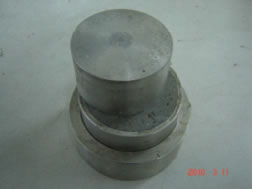- 首頁
- 技術資料|Technical data
-
超早強水泥砂漿
固岩3562 SHOT Cement速硬灰泥 固岩3582剛性路面&混凝土橋樑用快速水泥修材料 固岩3582.37 快速水泥灌漿材料 固岩3582-4.0 剛性路面 &混凝土橋樑用 超早強水泥修補砂漿 固岩3582.45 速硬水泥灌漿材料 -
不收縮摻劑&砂漿
固岩3710不收縮灌漿用水泥砂漿 固岩3783 特殊水泥砂漿 Calx-E18 Injection Agents灌漿摻劑 Calx-E12無收縮灌漿摻劑 固岩725 Powder套管灌漿助劑 -
複合防水材料
固岩3684軟性壓克力水泥 固岩3598 彈性樹脂砂漿複合材 固岩3618彈性塗膜防水複合材 -
混凝土鋼筋外露補修
固岩3731粗狀面-混凝土修補灰泥 固岩3702 細粒面-混凝土修補灰泥 固岩3741 輕質混凝土修補材 -
隧道材料
SN急結劑管&MORTAR SN 填加材 樹脂膠囊 Vise-E16 噴凝土速凝劑 SHOT-Q10 -
地坪材料
固岩3628 水性樹脂砂漿地坪鏝料 固岩3510 自平性地坪砂漿 固岩3548 特殊水泥地坪砂漿 -
其他材料
固岩3200 滲透型無機防水複合材
技術資料
Technical Data-
作者:Chris Chou
簡單認識無收縮水泥砂漿材質及檢測
無收縮水泥砂漿分類說明預(廠)拌無收縮水泥砂漿包裝料:
為收縮補償性水泥性質灌漿料。是乾粉狀,預拌式水泥砂漿。主要是由水泥、石英砂,多種特殊添加劑等複合而成。使用時僅須添加設定用水量,便可製成易流動,不收縮性,高強度灌漿用水泥砂漿。
施工現場拌合無收縮水泥砂漿料:
主要基材是水泥、砂(石英砂 or 河砂),與無收縮添加劑(or膨脹劑)。使用時將各種基本材料按一定配比,加水混合而成,便可製成無收縮水泥砂漿。
特性比較表:
預(廠)拌無收縮水泥砂漿包裝料 施工現場拌合無收縮水泥砂漿料 基本材料配比 穩定 現場施工,砂的粗細及含泥量,無標準之計量器,混合比率混亂! 混合均勻性 工廠標準配比,機械混合均勻。施工現場時,添加設定用水量後,即可使用 無精確計量,配比無法正確,僅根據施工人員之人為判斷添加,均勻度不足! 攪拌混合時間 添加設定用水量後,約2-3分鐘之拌合即可灌漿 必須先將水泥砂漿之基本材完全混合均勻後才可以灌漿,每次約5-10分鐘。根據施工現場觀察,多數施工之攪拌時間不足!混合嚴重不均勻! 用水量
(w/c)用水量(w/c) 所有基本材料均工廠內乾燥處理,定量機械混合包裝。設定用水量準,不影響材質特性 用水量(w/c) 所有基本材料均工廠內乾燥處理後,定量機械混合包裝,設定用水量準確,不影響材質特性。 因施工現場氣候問,所有室外堆置之基本材料含水率無法計,尤其砂之游離水的不均勻,影響用水量的正確判,造成材質特性低劣 流動性
ASTM C1437
ASTM C230
ASTM C827
ASTM C939由於拌合均勻穩定,流動性佳。細小之間隙均可填充。 拌合不均勻,用水量及流動性不穩定。用水量太大會造成粒料分離嚴重阻塞,灌漿體填充不均勻!
用水量太少,無法灌漿。因此施工現場多為超量添加用水。常見之現象,泌水與細小間隙組塞!可操作時間 拌合後約20-40分鐘(根據現場溫度) 不穩定,根據用水量及配比變動,差異極大。亦有不能凝結之現象發生! 強度
ASTM C109檢測強度均大於要求強度 不穩定! 收縮率 無收縮現象,可於試驗室進行抽驗檢測 多為收縮現象,無法檢測。目前國內之規範(公共工程施工綱要規範第 03601章 無收縮水泥砂漿)均無檢測現場拌合之收縮規定! 非金屬檢測
(XRD分析圖)
CNS 1078-90不含氯化物、鐵金屬,不會腐蝕及造成鏽點,或因鏽蝕膨脹造成金屬惡化。 主要成分:C3S(Ca54MgAl2SiO90)&SiO2 成本因素,現場添加不易檢測之故,多有損害之金屬含量。如鐵鋁鋅鎂發泡添加劑! 膨脹率
ASTM C827
ASTM C1090
CRD C621可於現場隨機取樣,再至試驗室測試 目前國內無檢測規範,可參考規範如下: 價格 材質正確穩定,品質佳,成本較高.約25,000-3,0000元/m3 基本材料取得無法驗證,成本低廉。約10,000-15,000元/M3 國內大量
使用之工程目前以橋樑耐震補強與擴建工程,橋墩及基礎鋼板灌漿使用最多 目前以橋樑耐震補強與擴建工程,橋墩及基礎鋼板灌漿使用最多 -
無收縮水泥砂漿(第 03601章 V3.1)檢驗標準修訂版
根據公共工程技術資料庫專案計畫,於中華民國 98年 3月 5日所頒布之修正條文(098 營建產字第09800000236號):
1.2.1無收縮性水泥是由水泥、淨砂與無收縮附加劑(無收縮性水泥化學摻劑)經過適當之配比及均勻之拌和後而製成,其不得有收縮作用。
1.5.1 無收縮化學摻劑(1)無收縮化學摻劑料應屬非金屬氧化性產品,由工程師認可後方得使用。
2.1.4 無收縮水泥砂將不得有收縮作用(即收縮率為 0%),依據 ASTM C827試驗之規定,終凝時膨脹率為 0.0-4.0%, 另依據 ASTM C1090試驗之規定,硬固後1,3,14及28天之膨脹率為 0.0-0.4%。結論:
1.無收縮水泥砂漿之用設定水量非常嚴格,增加2%以上之用水誤差都可以造成泌水、收縮、降低強度等問題。倘若不審慎有效規範,將造成許多重大工程之嚴重後續問題。如橋樑耐震補強工程,將嚴重影響鋼板包覆與原有墩柱間之力量傳遞問題;不正確之現場添加料(腐蝕性),將影響鋼材之鏽蝕問題;橋樑伸縮縫澆置,將持續有破裂之現象發生等。以上除結構破壞之外,還影響到使用者之安全。
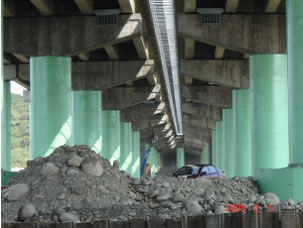

2.目前,國內之無收縮水泥砂漿灌注作業,多數承包商受限於成本考量,而採取工地現場拌合施工。價格低廉,施工品質不佳,監控檢驗不易! 倘若採用之膨脹添加劑不經嚴格控管,常有誤用不當之含腐蝕性摻劑易造成鋼板材腐蝕。
3.現場檢測: 業主、設計及監造單位也希望,能擬出一套【現場拌合無收縮水泥砂漿之管理檢測辦法】。經查閱紀錄,台灣高鐵速鐵路工程於施工期間,國外JV營造公司曾引用相關之無收縮水泥砂漿現場檢測作業程序,嚴格控制無收縮水泥砂漿品質,效果良好,值得參考。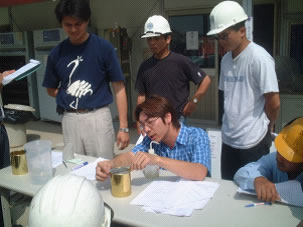
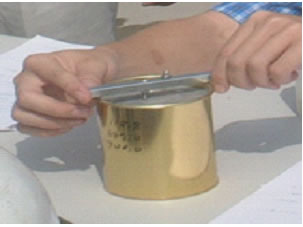
同時,其他相關法規如下,可引用為【現場拌合無收縮水泥砂漿之檢測規範】: 檢測頻率、膨脹率
相關規範ASTM C827
Standard Test Method for Change in Height at Early Ages of Cylindrical Specimens from Cementitious Mixtures1
1.4 The phrase “early age change in height” as used herein, is defined as the measured increase or decrease in height of a laterally confined cylindrical test specimen from the time of casting to when the mixture becomes hard. The user may want to define this age as the time when a companion specimen of the same batch has reached the time of final setting by Test Method C 191 (paste), C 953 (mortar or grout), C 403 (concrete), or establish a predetermined age in minutes from the time the specimen is cast as the defined age to record the final measurement. Changes in height are measured and expressed as a positive or negative change in the height of a test specimen that is restrained from lateral movement.
7. Preparation of Mixtures
7.1 General—Bring all materials to a temperature of 21 6 3°C (or 70 6 5°F) before mixing. In the case of field-mixed materials (現場拌合材料), record the temperature of the mixture just prior to placing in a test cylinder as well as the ambient temperature of the test area immediately around the specimen. Proportion all materials by mass in accordance with the specifications for the cementitious mixtures to be tested.
7.2.2 Determine the consistency of the mixtures by the flow test in accordance with the applicable provisions of Method C109;if when this procedure is used, the flow after 5drops of the flow table in 3s is 145 or less. A plastic mixture should have a flow of 100 to 125, and a flowable mixture should have a flow of 125 to 145 when tested by the above modification of Method C109. Mixtures. Having greater fluidity should be tested using the flow cone procedure of Method C939. A fluid mixture should have a time of efflux of 10 to 30 s when tested by the flow cone procedure.
9.2 Test Measurements Note 4-Time of hardening may be taken as the time of final set as determined by C 191 for cement pastes, C 953 for mortars and grouts, and C 403 for concrete mixtures.ASTM C953
Standard Test Method for Time of Setting of Grouts for Preplaced-Aggregate Concrete in the Laboratory1
2.1 ASTM Standards: C 191 Test Method for Time of Setting of Hydraulic Cement by Vicat Needle(維克針).
6. Test Sample
6.1 The test sample shall consist of at least 300 mL of grout taken from a freshly-mixed batch prepared in accordance with Practice C 938 obtained from a mixer at the laboratory or construction site(工地現場).ASTM C191
Standard Test Method for Time of Setting of Hydraulic Cement by Vicat Needle(維克針)
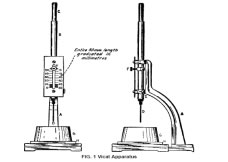
ASTM C938
Standard Practice for Proportioning Grout Mixtures for Preplaced-Aggregate Concrete1
2. Referenced Documents
2.1 ASTM Standards:ASTM C940
Standard Test Method for Expansion and Bleeding of Freshly Mixed Grouts for Preplaced-Aggregate Concrete in the Laboratory1
9.2 When sampling and testing are being performed in the field, record the temperature of the grout sample and the ambient temperature of the area in which the test readings are made. Record the time interval between completion of mixing and start of test.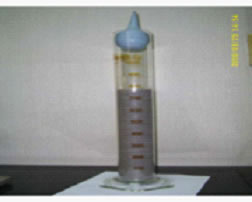
ASTM C1107
Standard Specification for Packaged Dry, Hydraulic-Cement Grout(Nonshrink)1
Compressive Strength,min psi (Mpa) 1 dayA 1000 (6.9) 3 day 2500 (17.2) 7 day 3500 (24.1) 28 day 5000 (34.9) -A- -B- -C- Prehardening Post Hardenig Combination Grade Classification Volume Volume Volume Controlled Controlled Controlled Type Type Type Early Age Height change Max % @ Final Set +4.0 NA +4.0 Min % @ Final Set 0.0 NA 0.0 Height Change of Moist Cured Hardened Grout at
1,3,14and 28 DaysMaximum,% NA +0.3 +0.3 Minimum,% 0.0 0.0 0.0 ASTM C1090
Standard Test Method for Measuring Changes in Height of Cylindrical Specimens from Hydraulic-Cement Grout1
8.1 The laboratory air shall have a temperature of 23±2°C (73±3℉), and a relative humidity of not less than 50 %. Store the test specimen at a temperature of 23±2°C for the duration of the test, unless otherwise specified. When it is desired to test the height change of material that is permitted to be used in the field at temperatures either below or above 23±2°C, use such other temperatures controlled to ±2°C (3°F) throughout instead of23±2°C. Record the temperature of the mixing water, other materials, and of the mixture immediately after mixing is completed. Store the height-change apparatus in air at the desired test storage temperature within±2°C before casting the specimen.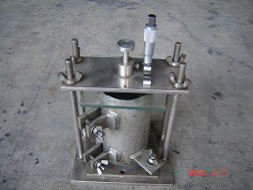
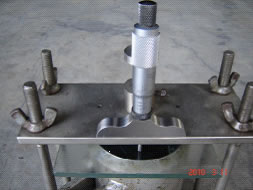
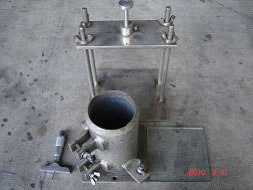
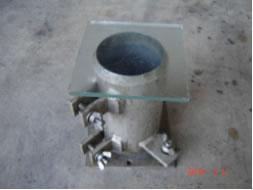
CRD-C621
Corps of Engineers Specification for Nonshrink Grout shall have no shrinkage (0.0 percent) and a maximum of 0.4 percent expansion in the hardened state when tested in accordance with CRD C 621.
4.Requirements 4.1 When tested as provided for herein, a grout shall meet the following performance requirements:
4.1.1 Expansion. % 3. 14. Expansion. % 3. 14. And 28 days any of these ages 4.1.2 shrinkage None (b) 28 days 4.1.3 Compressive strength
psi (MPa). min
7 days
28 days2500(17.2)
5000(34.5)4.1.4 Time of final ht. max 4.1.5 Fluidity High fluidity (Fluid) 10-30 sec (d) Moderate fluidity (Flowable) 124-145 flow (e) Minimum fluidity 100-125 flow (e) 抗磨擦:

